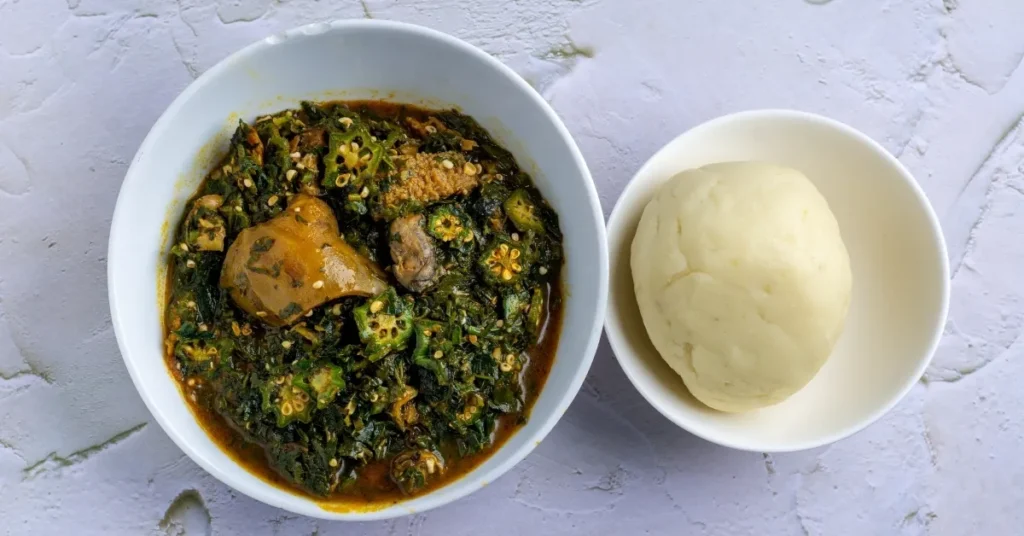Read time : 4 minutes

Traditional African cuisine is celebrated globally for its vibrant flavors, cultural richness, and reliance on fresh, wholesome ingredients. From Nigeria’s leafy “efo riro” to The Gambia’s hearty “domoda” peanut stew, these dishes are often hailed as nutritional powerhouses. A common belief persists that because these meals are “natural” or “traditional,” they can be eaten in unlimited quantities without health consequences. But is this true? Let’s find out!
The Nutritional Strengths of Traditional African Diets
African culinary traditions are rooted in nutrient-dense ingredients: leafy greens, legumes, lean proteins, and unprocessed staples. For example:
- Nigerian “efo riro”: Packed with spinach, peppers, and fish or turkey, it’s rich in iron, vitamins, and omega-3 fatty acids.
- Ghanaian “kontomire” stew: Made with “cocoyam” leaves, it’s a source of fiber, vitamin A, and calcium.
- Gambian “domoda”: A peanut-based stew with tomatoes and meat, offering protein, healthy fats, and antioxidants.
These dishes exemplify balanced meals that align with modern dietary guidelines. However, this doesn’t mean every component of a traditional plate is low-calorie or immune to Overconsumption.
Why “Healthy” Doesn’t Mean “Unlimited”
The idea that portion sizes don’t matter for traditional African foods is a dangerous oversimplification. While fresh vegetables and lean proteins are excellent choices, many meals also include calorie-dense staples like:
- “Fufu” (pounded cassava/yam) and “eba” (gari): These starchy accompaniments are high in carbohydrates, providing quick energy but contributing to calorie surplus if portions exceed bodily needs.
- Palm oil-based soups: Though rich in vitamin E, palm oil is calorie-heavy, a little goes a long way.
A 2020 study in The Journal of Nutrition found that even nutrient-rich traditional diets can lead to weight gain when portions aren’t aligned with individual energy requirements. For instance, oversized servings of “fufu” paired with protein-rich soup might deliver twice the calories a sedentary office worker needs in one meal.
Cultural Context vs. Modern Lifestyles

Historically, African diets evolved to fuel physically demanding agrarian lifestyles. Meals were designed to sustain labor-intensive days. However, modern sedentary lifestyles mean fewer calories are burned, yet portion sizes often remain unchanged. This mismatch can quietly lead to weight gain, insulin resistance, or hypertension even if the diet is “traditional.”
How to Enjoy Traditional Meals Mindfully
Rejecting cultural foods isn’t the solution. Instead, balance and mindfulness are key:
- Downsize starchy staples: opt for smaller portions of “fufu”, “eba”, or rice. Fill half your plate with vegetables.
- Cook with moderation: Use palm oil sparingly; prioritize steaming or baking over frying.
- Listen to your body: Eat slowly and stop when full—traditional meals are often shared, so pace yourself.
- Adapt to your activity level: Adjust portions based on your daily movement. A farmer’s needs differ from a desk worker’s.
The RD’s Final Take 👎
“Traditional African diets have undeniable strengths, but portion control is non-negotiable for long-term health,” says Registered Dietitian Julius Sammah. “It’s not about rejecting culture, it’s about honoring it by eating intentionally.”
RD, LD Julius Sammah
MyHealthCop Certified Dietician
Ready to Take the First Step?
👉 Book a 1-on-1 Session with any of our Certified professionals to start your health journey today. [DOWNLOAD THE APP]